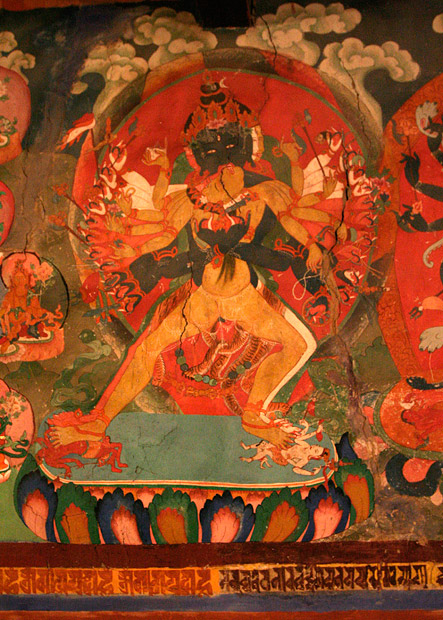See glossary for meaning of terms marked in bold below.
How can a photographer assume rights to treat a human being like an inanimate exhibit? It is hard for me to conceive stepping right into someone’s personal space with a big mean digital SLR and shoot a few hundred images using a long lens poking up to the nose of the person being photographed. As if that is not bad enough, the photographer never spoke a word. No smile, not even a hello. Instead, he went on clicking as though he was shooting a sheep, or even worse, a museum piece. He took his time to take pictures from various angles and went satisfied only after every inch of his subject was photographed.
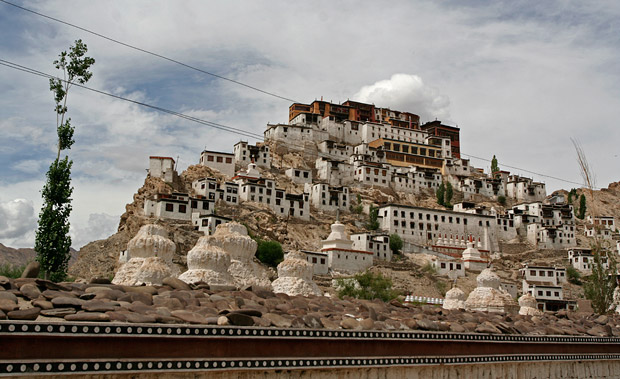
Yet, lama Sherap did not seem annoyed. He did not even blink at the photographer or showed the slightest discomfort. He simply continued at his work and once in a while looked up and smiled. He wasn’t perturbed even when the smile did not result in a reciprocation. After the mean photographer left without saying a ‘thank you,’ he looked at me and smiled as if telling me not to bother. I was sitting there talking with lama Sherap for a while and was very annoyed by the photographer’s behaviour. But the lama himself seemed to live up to what they learn – he was perfectly composed and simply resumed his work as though nothing happened.
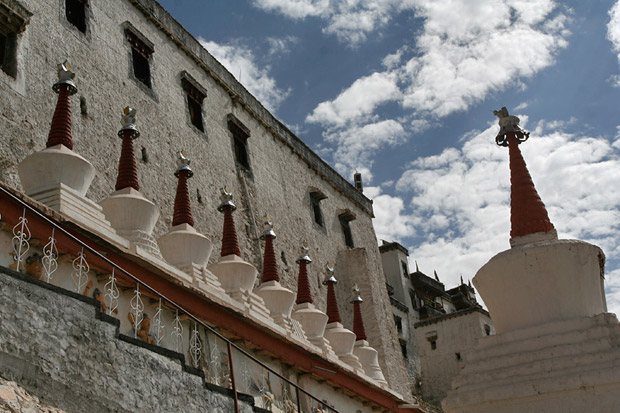
Lama Sherap was taking care of the du-khang that day. He was alone in the prayer hall as his companions had gone to the village to perform some rituals. He was friendly, approachable and smiled gently every time he spoke. Sitting on the floor close to the entrance of the hall, he busied himself kneading chunks of tsampa (barley flour) and preparing torma. He explained me what torma is and helpfully added that it is for some special prayers being performed tomorrow.
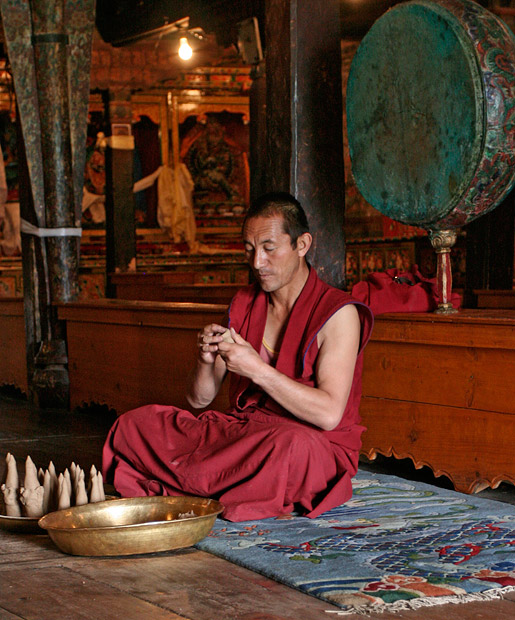
As I sat and talked to with him, a Ladakhi woman walked in, greeted the lama with a smile and a ‘julley’, prostrated repeatedly towards the altar and and left as quickly as she came. Tourists kept coming in packs, took pictures and left within minutes, having ticked Thiksey off their list. After the nosy photographer completed his work, lama Sherap asked me how a digital camera works.
‘Today’s cameras don’t have film rolls and you can see the pictures at the back of them,’ he said, ‘where do the photos get recorded?’ I took out the CF card from my camera and showed him in answer. His next questions came immediately.
“How may photos get stored on them? They could get 36 in a roll of film. In which country do they make these things?”
After satisfying his curiosity, it was my turn to ask questions. Lama Sherap showed me a statue of Tson-ka-pa, helpfully identified it for me and explained that the monastery belongs to Gelugpa order. ‘There are about a hundred lamas,’ he said, ‘some are young lads and some are more than forty years old.’
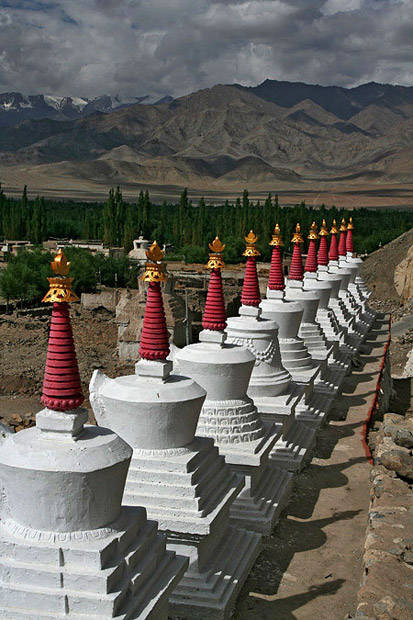
As long as I was with him, he never saw his smile go away. When tourists misbehaved, sitting on the carpets that were meant only for lamas, he would wait to see if they would rise soon and then offer them another seat. There was not the slightest hint of irritation or anger despite repeated violation of regulations by visitors. Later at chon-kor, the room with a large idol of Buddha Maitreya, I saw a visitor stumble and drop a lamp on the floor and guiltily look at the monk taking care of the room, only to see him smiling. What could be an embarrassing moment was instantly dissolved in those smiles.
The chon-kor has an impressive 2-storey high statue of Buddha Maitreya. The tall Maitreya sits in padamasana (lotus position) and has a calm unblemished face. His lotus-like crown is embellished with images of reincarnations of Buddha. His large ornate ear rings complement the crown and stand out against the turquoise outfit.
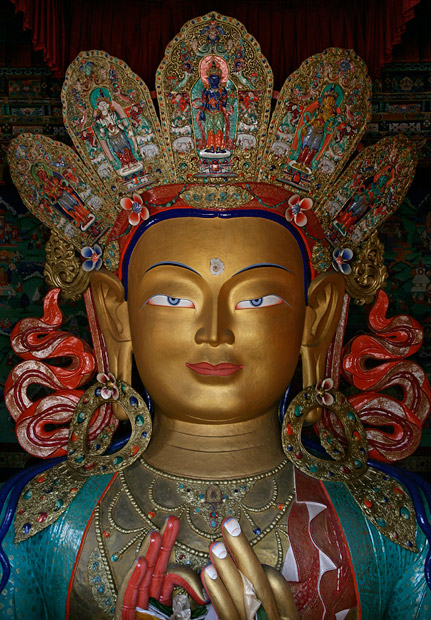
The Maitreya statue is relatively new, inaugurated in 1980 by Dalai Lama. The monastery itself was founded in early 15th century. Walking up the crag where a group of haphazardly built buildings of the monastery are located, it is evident that the institution has grown and expanded over the years. I climb up the steps leading to the monastery past a latest addition – a newly built row of chortens.
Inside, the du-khang seems to be old enough to be one of the first buildings built. To each side of its entrance are the colourful murals of the deities of the four directions, while inside walls are painted with various forms of Buddha and Yab Yum. At the rear side of du-khang is a small chapel with metallic statues of Tson-ka-pa and Manjushri.
The paintings on the outer walls have a curious diversion from tradition. The samsara-chakra has figures wielding guns and wearing clothes more suited for British and Indian men of the plains a few hundred years ago.
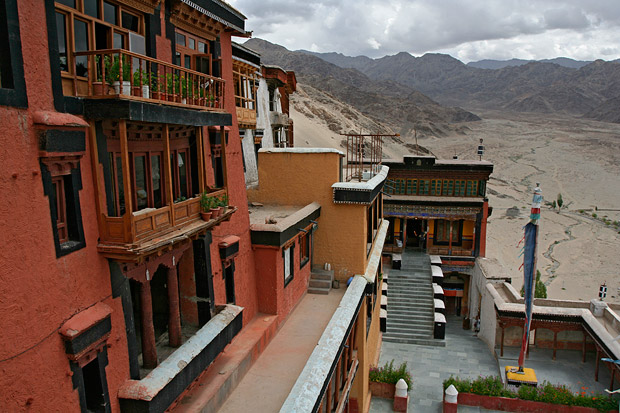
The stairs next to the du-khang lead to the terrace from where I can see the barley fields spread along the valley, the river coiling through the fields and the mountains beyond. In the corner of the terrace is a small room – a library filled with ancient Tibetan scriptures. As I descend from the stairs and head out to the valley, it is the smiles of Lama Sherap and the calm face of Maitreya that stay in my memory, etched stronger than the photographs I clicked in the monastery.
I went to Thiksey Village to see the monastery, but was charmed by the barley fields around the village more than the monastery itself.
See glossary for meaning of terms marked in bold below.
On my way to Ladakh from Manali, I had presumed entire Ladakh as a calm and pleasant region with a soothing feel and a mystic charm. But the urban growth and its ugly suburbs had baffled me, making me wish to move away from the town. Thiksey provided the necessary escape.
After having gone through the barren landscapes along the Manali-Leh road and spending days in Leh looking up at arid mountains all around the town, the greenery along the Indus Valley gave a welcome break. The river basin is at its widest in Thiksey, mostly filled with barley fields, poplar groves and a few houses dotting the verdant landscape.
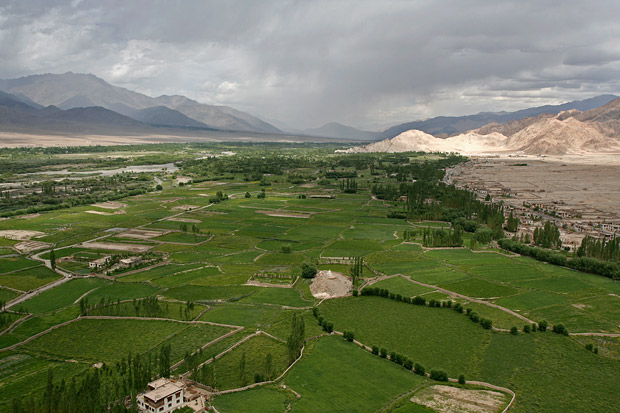
I walked through the fields listening to the cawing of bactrian magpies and watching a hoopoe lodge on the ground near me, spreading its crest like a fan and proudly demonstrating its beauty. Sparrows hopped around the fields in search of grain, chirping and flying away on my approach. The fields were crisscrossed by a complex array of canals with cold, crystal clear water coming down from the mountain peaks. A long Mani wall bordered the fields. Thin poplar trees grew tall and parallel to each other, forming boundaries between two patches of land. As the sun edged towards the mountain peaks in the west, the sky was painted in orange and shafts of light emerged from the gap in the clouds. Sunlight made way through the poplar trees, creating strips of light and shade on the ground.
A few women worked in the fields. Children gallivanted on the road, going back and forth without purpose.
Thiksey monastery was visible at a distance, perched high on a hill to the north, overlooking and guarding the village. Indus flowed somewhere below in the wide valley. Far away to the other side were the mountains of Zanskar, with their brown slopes and icy peaks. It was a beautiful world!
But there are some signs of Thiksey’s traditional barley fields giving way to development. Some fields were dug up for brick making, probably to satisfy the demand from Leh and to build accommodation for the summer rush of tourists. Poplar trees – another material used for construction – usually grown at the edge of the fields now completely occupied some areas.
As the sun went down the horizon and we headed back to our hotel, we met two soldiers from the nearby battalion. They were friendly and happy to talk, like most army men here were. Suman and Rishi have seen a winter here and can’t forget the harsh weather and sub-zero temperatures from those days.
‘It gets bitterly cold,’ they say, ‘-45C in winter. All the greenery that you are seeing today will be gone. There won’t be a shrub to see. The trees shed their leaves and look like skeletons. Nothing grows on earth. Vegetables cost ten times the summer prizes. The approach roads to Ladakh will be closed and there will be snow all over.’
Having seen a harsh winter, Suman preferred warmer climes. ‘You should go to Andamans,’ he told me, ‘see the sea there, go to Port Blair and visit the cellular jail.’ Without knowing, he was kicking up a wish I have had for a long time.
We parted ways and returned to the hotel, a place managed by the monastery administration. We intended to visit the monastery for the next morning prayers, but luck would go against us. Someone had died at the village yesterday and the monks were to go there to perform final rites. There would be no morning prayers in the monastery next morning.
To be continued..
Continuing my series of stories on Ladakh, I will be writing in upcoming posts about monasteries that I visited. It would be useful to know a few terms often associated with Ladakhi Buddhism and Tibetan iconography before reading them. I will be using these terms very often in the posts about monasteries. More terms may be added as necessary. Come back to this post for references where needed.
Avalokitesvara. The Buddha of compassion with thousand arms to help the sentient beings.
Chorten. A Chorten or a Stupa is a holy structure with three parts – a square bottom, a circular middle section and a thin cylindrical top portion. On the top of it will be a crescent moon and a disc. Chortens are installed on the approach to monasteries and outside the village. They are meant to ward off evil.
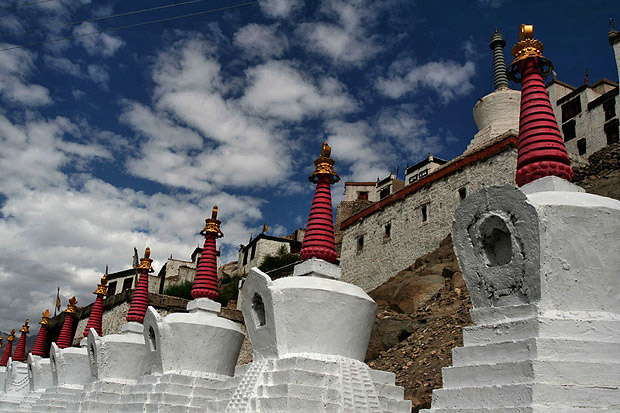
A series of Chortens.
Drukpa. A sect of Tibetan Buddhism, also referred to as Red Hat. The monasteries in Lamayuru and Hemis are among the prominent monasteries of this sect.
du-khang. The prayer hall of the monastery, often with richly decorated interiors and murals along the walls.
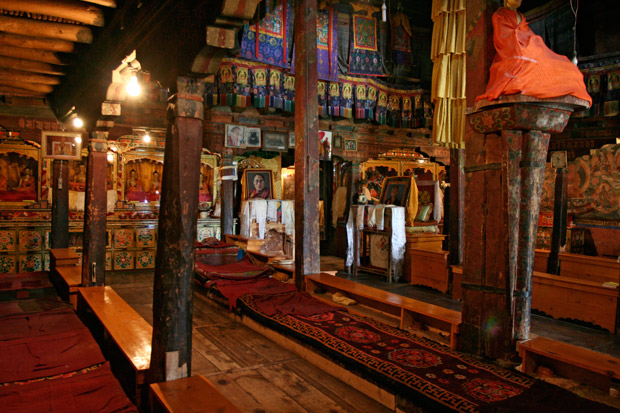
The du-khang in a monastery in Ladakh
Gelugpa. A sect of Tibetan Buddhism, also referred to as Yellow Hat. The monks of Gelugpa sect wear a tall yellow hat during special ceremonies and festivals. Most monasteries in Ladakh belong to this sect. Dalai Lama belongs to Gelugpa order.
Gompa. Ladakhi term for a monastery. Celibate monks (lama) live here and study the religious scriptures and meditation. Usually every village will have a gompa on a crag overlooking the entire village. Villagers use religious services of lamas from the monastery and often donate in cash or kind in return.
gon-khang. Gon-Khang or the room of guardian deities is a place of worship in the monastery that houses many demonic figures. Sometimes the deities are veiled. Some monasteries do not permit women inside gon-khang.
Mani wall. A thick wall built by loosely bound stones, often seen along the roads in a Ladakhi village. The stones will have ‘Om Mani Padmeham’ or other Tibetan mantras inscribed on them. One must always walk keeping the Mani wall to the right.
Manjushri. Manjushri is a Bodhisattva (emanating enlightened being) associated with awareness.
Tara. A female deity. Tara is usually painted in prayer halls as Green Tara or White Tara.

A statue of Tara
Torma. A material for worship made by kneading tsampa(barley flour) in to conical shape and decorated with Yak butter and other materials.
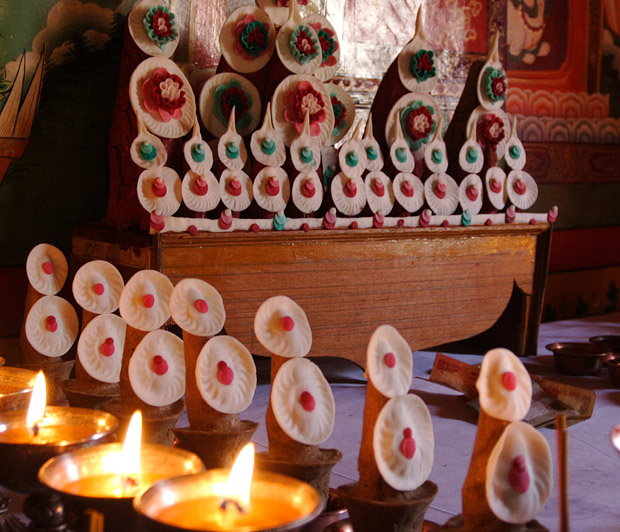
Tson-ka-pa. The lama who founded of Gelugpa sect. His statues and paintings can be seen in many monasteries that belong to Gelugpa sect.
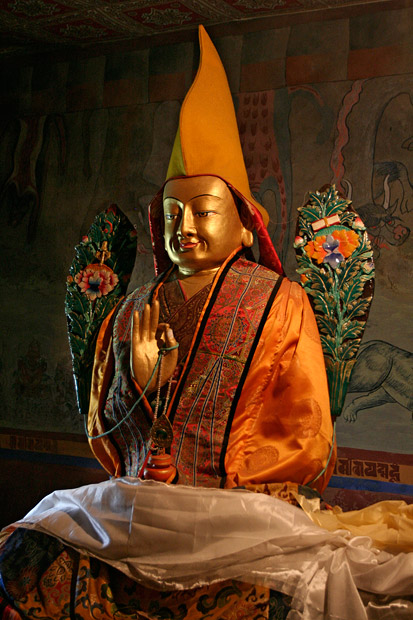
A statue of Tsonkapa
Wheel of Life. A complex painting often seen on the walls of monasteries, representing various levels of life according to Tibetan Buddhism.
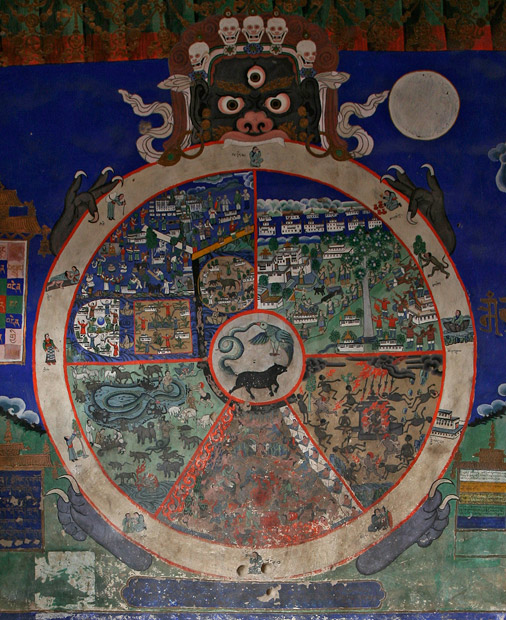
Yab Yum. A Tibetan Buddhist deity with multiple hands, always portrayed in union with a female deity. Paintings of Yab Yum can be seen in the prayer halls of the monasteries.
